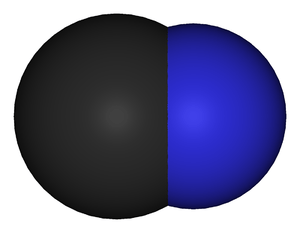Ammonium cyanide
 | |||
| |||
| Identifiers | |||
|---|---|---|---|
| 12211-52-8 | |||
| 3D model (Jmol) | Interactive image | ||
| ChemSpider | 140210 | ||
| PubChem | 159440 | ||
| |||
| |||
| Properties | |||
| NH4CN | |||
| Molar mass | 44.0559 g/mol | ||
| Appearance | colourless crystalline solid | ||
| Density | 1.02 g/cm3 | ||
| Boiling point | 36 °C (97 °F; 309 K) | ||
| very soluble | |||
| Solubility | very soluble in alcohol | ||
| Related compounds | |||
| Other anions |
Ammonium hydroxide Ammonium azide Ammonium nitrate | ||
| Other cations |
Sodium cyanide Potassium cyanide | ||
| Related compounds |
Ammonia Hydrogen cyanide | ||
| Except where otherwise noted, data are given for materials in their standard state (at 25 °C [77 °F], 100 kPa). | |||
| | |||
| Infobox references | |||
Ammonium cyanide is an unstable inorganic compound with the formula NH4CN.
Uses
Ammonium cyanide is generally used in organic synthesis. Being unstable, it is not shipped or sold commercially.
Preparation
Ammonium cyanide is prepared in solution by bubbling hydrogen cyanide into aqueous ammonia at a low temperature
- HCN + NH3(aq) → NH4CN(aq)
It may be prepared by the reaction of calcium cyanide and ammonium carbonate:
- Ca(CN)2 + (NH4)2CO3 → 2 NH4CN + CaCO3
In dry state, ammonium cyanide is made by heating a mixture of potassium cyanide or potassium ferrocyanide with ammonium chloride and condensing the vapours into ammonium cyanide crystals:
- KCN + NH4Cl → NH4CN + KCl
Reactions
Ammonium cyanide decomposes to ammonia and hydrogen cyanide, often forming a black polymer of hydrogen cyanide:
- NH4CN → NH3 + HCN
It undergoes double decomposition reactions in solution with a number of metal salts. It reacts with glyoxal, producing glycine (aminoacetic acid):
- NH4CN + (CHO)2 → NH2CH2COOH + HCN
Reactions with ketones yield aminonitriles:
- NH4CN + CH3COCH3 → NH2CH2CH2CH2CN + H2O
Toxicity
The solid or its solution is highly toxic. Ingestion can cause death. Exposure to the solid can be harmful as it decomposes to highly toxic hydrogen cyanide and ammonia.
Chemical analysis
Elemental composition: H 9.15%, C 27.23%, N 63.55%.
Ammonium cyanide may be analyzed by heating the salt and trapping the decomposed products: hydrogen cyanide and ammonia in water at low temperatures. The aqueous solution is analyzed for cyanide ion by silver nitrate titrimetric method or an ion-selective electrode method, and ammonia is measured by titration or electrode technique.
Notes
References
- A. F. Wells, Structural Inorganic Chemistry, 5th ed., Oxford University Press, Oxford, UK, 1984.
| Salts and covalent derivatives of the cyanide ion | |||||||||||||||||||
|---|---|---|---|---|---|---|---|---|---|---|---|---|---|---|---|---|---|---|---|
| HCN | He | ||||||||||||||||||
| LiCN | Be(CN)2 | B | C | NH4CN | OCN−, -NCO |
FCN | Ne | ||||||||||||
| NaCN | Mg(CN)2 | Al(CN)3 | SiCN | P(CN)3 | SCN−, -NCS, (SCN)2, S(CN)2 |
ClCN | Ar | ||||||||||||
| KCN | Ca(CN)2 | Sc(CN)3 | Ti(CN)4 | VO(CN)3 | Cr(CN)3 | Mn(CN)2 | Fe(CN)3, Fe(CN)64+, Fe(CN)63+ |
Co(CN)2, Co(CN)3 |
Ni(CN)2 Ni(CN)42− |
CuCN | Zn(CN)2 | Ga(CN)3 | Ge | As(CN)3 | SeCN− (SeCN)2 Se(CN)2 |
BrCN | Kr | ||
| RbCN | Sr(CN)2 | Y(CN)3 | Zr(CN)4 | Nb | Mo | Tc | Ru | Rh | Pd(CN)2 | AgCN | Cd(CN)2 | In(CN)3 | Sn | Sb | Te(CN)2, Te(CN)4 |
ICN | XeCN | ||
| CsCN | Ba(CN)2 | Hf | Ta | W | Re | Os | Ir | Pt | Au | Hg2(CN)2, Hg(CN)2 |
TlCN | Pb(CN)2 | Bi(CN)3 | Po | At | Rn | |||
| Fr | Ra | Rf | Db | Sg | Bh | Hs | Mt | Ds | Rg | Cn | Nh | Fl | Mc | Lv | Ts | Og | |||
| ↓ | |||||||||||||||||||
| La | Ce(CN)3, Ce(CN)4 |
Pr | Nd | Pm | Sm | Eu | Gd(CN)3 | Tb | Dy | Ho | Er | Tm | Yb | Lu | |||||
| Ac | Th | Pa | UO2(CN)2 | Np | Pu | Am | Cm | Bk | Cf | Es | Fm | Md | No | Lr | |||||

